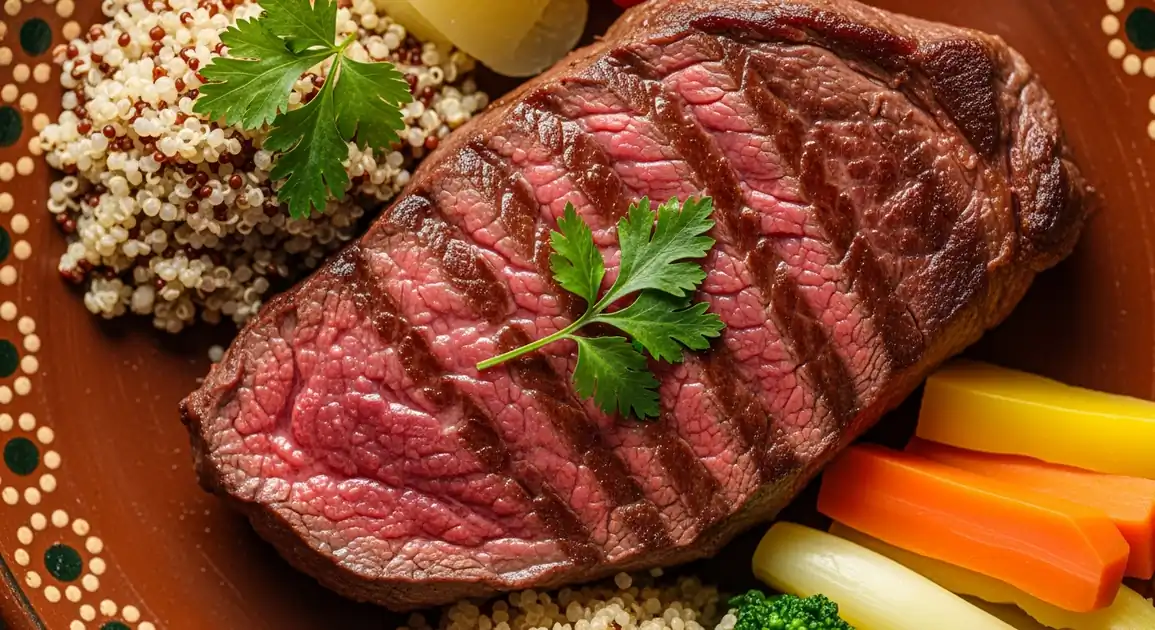Alpaca Steak
Bistec de Alpaca

Description
Alpaca meat is consumed throughout the Peruvian highlands, where these camelids are native and have been domesticated for thousands of years. While traditionally more common in rural indigenous communities, alpaca steak has become increasingly available in restaurants in major tourist centers like Cusco, Arequipa, and Puno, particularly those showcasing traditional and novo-Andina cuisine.
Dietary Information
Serving information
Serving style
Typically served plated in restaurants, presented similarly to beef steak. Usually accompanied by Andean side dishes like quinoa, native potatoes (papas nativas), corn, or local vegetables. Often garnished with fresh herbs and served with a sauce on the side.
Quick facts
Most restaurants serve alpaca steak during standard dining hours: lunch (12 PM - 3 PM) and dinner (6 PM - 10 PM).
Safety Tips
What to Look For
-
Proper cooking temperature
Alpaca should be cooked to at least medium (internal temperature of 145°F/63°C) to ensure food safety while maintaining tenderness.
-
Clean, reputable establishments
Choose restaurants with good hygiene standards, ideally those recommended in guides or with positive reviews from other travelers.
-
Freshly prepared meat
The meat should be served hot and freshly prepared, not reheated or sitting under warmers.
-
Proper meat color
Cooked alpaca should have a caramelized exterior and be pinkish-brown to light brown inside, not red or raw-looking.
What to avoid
-
Very rare or raw alpaca
Unlike beef, alpaca should never be consumed rare or raw due to the risk of parasites or bacteria.
-
Suspiciously low prices
Extremely cheap alpaca dishes might indicate poor quality meat or potentially substituted meat (like llama or even beef).
-
Strong gamey or ammonia smell
Fresh alpaca has a mild aroma; strong odors indicate poor quality or improper storage.
-
Street vendors selling alpaca
Alpaca requires proper refrigeration and cooking equipment; it's rarely sold safely by street vendors.
Price information
Price range
Budget tips
- Lunchtime 'menú del día' specials sometimes include alpaca dishes at lower prices than evening à la carte options.
- Prices are typically higher in restaurants directly on Plaza de Armas in Cusco; walk a few blocks away for better values.
- Local 'picanterías' often offer more affordable alpaca dishes than tourist-oriented restaurants.
Value indicators
- Proper portion size (typically 180-220g of meat).
- Quality of accompaniments (freshness of vegetables, variety of native potatoes or Andean grains).
- Proper cooking expertise (caramelized exterior, tender interior).
- Thoughtful presentation showing care in preparation.
Where to Find This Dish
Tourist Districts
Most readily available in restaurants catering to tourists in major Andean cities.
Plaza de Armas (main squares), Historic centers
Evening (6 PM - 10 PM)
Traditional Markets
Some food stalls in large markets may offer alpaca dishes, though steaks are less common than stews in these settings.
San Pedro Market (Cusco), Mercados de abastos (supply markets)
Lunch (12 PM - 2 PM)
Rural Communities
Traditional preparation of alpaca can be found during special events or community feasts in highland villages.
Andean villages, Community centers
During festivals and celebrations
Vendor Tips
- Ask if the alpaca is 'de la región' (from the region) to ensure freshness and authenticity.
- Look for restaurants that explicitly mention alpaca sourcing or sustainability.
- In tourist areas, restaurants with mainly local clientele often serve more authentic preparations.
How to Order
Regional Variations
-
Grilled Alpaca Steak
(Bistec de Alpaca a la Parrilla)
Classic preparation where the steak is grilled over open flame or coals, typically seasoned simply with salt, pepper, and sometimes Andean herbs.
-
Alpaca Saltado
(Lomo Saltado de Alpaca)
A fusion dish combining Chinese stir-fry techniques with Peruvian ingredients. Strips of alpaca are stir-fried with onions, tomatoes, ají amarillo (yellow chili pepper), and sometimes french fries, served with rice.
-
Alpaca with Andean Sauce
(Alpaca en Salsa Andina)
Steak served with sauces made from local ingredients like huacatay (Andean mint), rocoto pepper, native herbs, or fruit reductions (often from aguaymanto or sauco berries).
-
Alpaca Anticuchos
(Anticuchos de Alpaca)
Peruvian-style skewers of marinated alpaca meat pieces, grilled and served with potatoes and corn.
-
Alpaca Carpaccio
(Carpaccio de Alpaca)
A modern interpretation found in upscale restaurants; thin slices of cured (not raw) alpaca served with Andean herbs, olive oil, and sometimes native cheese.
Cultural context
History
Alpacas have been domesticated in the Peruvian Andes for over 6,000 years, primarily for their fine wool. Historically, their meat was consumed during special occasions or when animals were culled from the herd. While indigenous communities have long included alpaca in their diet, its preparation as a steak (bistec) catering to international tastes is a more recent development, coinciding with the growth of tourism in Peru and the emergence of novo-Andina cuisine that reinterprets traditional ingredients with modern cooking techniques.
Local significance
Alpaca meat represents the sustainable agricultural practices of the Andes that have existed for millennia. While the animals are primarily valued for their wool, utilizing their meat reflects the traditional Andean philosophy of making complete use of resources.
Eating customs
- Typically eaten with traditional Andean side dishes like quinoa, chuño (freeze-dried potatoes), or mote (Andean corn).
- Often accompanied by ají sauces for added flavor.
- In restaurants, it's acceptable to specify your preferred doneness, though medium to medium-well is traditional.